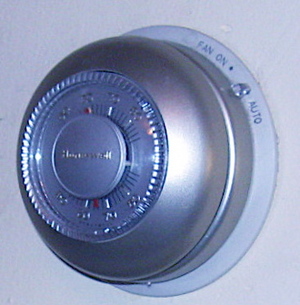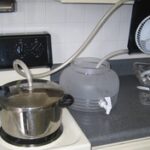Replacing a five wire thermostat for your gas/electric heat and AC system with a new digital thermostat or a standard thermostat can be a relatively simple task when given the proper instructions, and by doing it yourself you can save enough money on technician fees to buy a higher quality thermostat than what you may have been able to afford otherwise. In addition, installing a new thermostat can often improve the comfort of your home by eliminating those large temperature swings of your older thermostat and improve the efficiency of your system as well.
What you will need
Small screwdriver
Wire strippers
Level
Pen and pad
What you need to know before you get started
Most gas/electric and AC thermostats only use 4 color coded wires to operate. A fifth wire is needed for a “Common” when the thermostat is both digital and powered by the AC unit instead of being powered by batteries. Otherwise, the “Common” wire is not needed for the thermostat to operate even if there is a connection within the thermostat for it.
The thermostat wire connectors are coded to match up with the color of the thermostat wires. Typically, “R” is for the red wire, “G” is for the green wire, “Y” is for the yellow wire, “W” is for the white wire, and “C” is for the blue or black wire (depending on which wire is chosen by the installer). The “C” connection is for the common wire. Also, sometimes in place of “R” you will find “RH” and “RC” connected together with piece of flat metal. The red wire can be connected to either as long as the metal strip that connects the two remains in place.
The red wire is the power wire; the green wire controls the fan; the yellow wire controls the AC; and the white wire controls the heat.
Instructions
1)Turn off the power to your heating and cooling system at the breaker or fuse box. The voltage used by your thermostat is low voltage and is not likely to cause electrocution; however, if the wires should touch each other during the replacement process, it could damage the furnace wiring.
2)Remove the existing thermostat cover and locate the wire connections. The cover can usually be removed by simply pulling it straight out, but sometimes the cover comes in two parts – one is pulled off while the second must have screws removed first. Also, some digital thermostats have a small slit that allows for a flat-head screwdriver to be inserted in order to pry the cover off.
3)Make notes as to the color of the wires and the letter next to the connection. Most thermostat wiring uses a standard color code but sometimes installers deviate from this standard. By noting which wires the installer used on the thermostat, you can be sure your new thermostat will work properly by connecting it in the same way. For example, if the existing thermostat has a brown wire connected to “W” instead of a white wire (the standard color used) then you know to connect this same wire to the “W” on your new thermostat.
4) Disconnect the wires from the old thermostat using the small screwdriver and then remove the screws that hold the thermostat in place on the wall. Most thermostats are mounted with small flat-head screws.
5) Remove the old thermostat and place the base of the new thermostat in its place. There should be a hole in the base for the wires to enter the thermostat. Your new thermostat may not line up exactly like the old one did. In other words, it sit more to one side or the other, depending on the size of the new one and the location of the hole where the thermostat wires enter.
6) Attach the new thermostat to the wall using the screws provided. Make sure the thermostat is level before completely tightening the screws.
7) Connect the thermostat wires to the connections in the new thermostat. Make sure there is good metal on metal contact between the wire and the connecter. In other words, you may have to remove some of the wire insulation if it is in the connection area. However, you do not want too much exposed wire past the connection point either. Cut some of the wire off if the wire insulation has been stripped too far back. Bare wires can touch other components and short out your thermostat or furnace.
8) Install the cover of your new thermostat and restore power to your system. You will want to systematically test the operations of your system to ensure a proper installation.
Testing your new thermostat
Start with the heat. Set the thermostat to “Heat” and adjust the temperature setting above the current room temperature. Allow one to five minutes for the system to start (some thermostats have time delays). After the system starts, check the vents to ensure it is actually producing heat and not just blowing.
Allow the system to run until the temperature setting is satisfied. The system should shut off within 30 to 90 seconds after the thermostat is satisfied (most systems continue to run after the thermostat signals for it to shut down – this allows for greater efficiency).
Repeat the process with the cooling.
Sources
“How to Make Your Furnace More Efficient” Associated Content
“How does a thermostat work?” Central Air-Conditioning and Refrigeration





